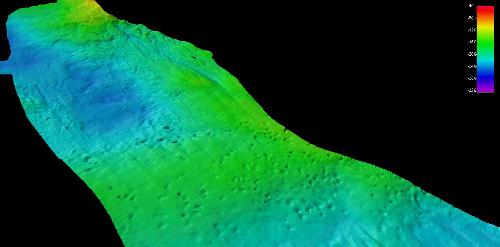The study indicates that under the frigid weight of Barents Sea Ice sheet, which covered northern Eurasia some 22 000 years ago, significant amounts of methane may have been stored as hydrates in the ground. As the ice sheet retreated, the methane rich hydrates melted, releasing the climate gas into the ocean and atmosphere for millennia.
This finding was published last week in Nature Communications in the paper "Ice-sheet-driven methane storage and release in the Arctic".
"Creation of gas hydrates requires high pressure; water; gas - mainly methane - and low temperatures. Nowadays we basically consider two environments suitable for this process to occur: subseabed along the world's continental margins, and permafrost areas on land and off shore. " Says principal author of the study, Dr. Alexey Portnov of CAGE - Centre for Arctic Gas Hydrate, Environment and Climate at UiT The Arctic University of Norway.

Ice sheets - a third process
But this is the first comprehensive study that shows that there is a third process that can create, contain and maintain large amounts of gas hydrates: ice sheets.
" They are heavy, can exert enormous pressure on the ground below. And they are cold, of course. With enough supply of gas and water from below and favorable geological setting you will likely have enormous amounts of gas hydrates contained under modern ice sheets as well".
500-meter thick methane reservoir
The theory that this may be happening beneath the Antarctic ice sheet has been published previously in Nature. CAGE-study is a more comprehensive take on that idea, and shows same processes taking place in the Arctic.
Scientists from CAGE have over time collected wide-ranging observational data offshore western Svalbard in the Arctic Ocean. This made it possible to create robust models for a scenario of subglacial evolution of gas hydrate reservoirs during and after Last Glacial Maximum, or last ice age in layman´s terms.
The results of the study indicate that even under conservative estimates of ice thickness a 500-meter thick gas hydrate stability zone existed beneath the ice sheet in the study area. This zone could have served as a methane sink-a reservoir containing immense amounts of the natural greenhouse gas. 1 m3 of gas hydrate contains almost 170 m3 of the greenhouse gas methane.
Rapid melt caused release of methane
During the last ice age the continental margin offshore western Svalbard, was land covered with ice, much as Greenland and Antarctica of today. But as the climate changed, the ice melted over a period of thousands of years, a rapid melt in geological terms.
The scientists have mapped over 1900 pockmarks - gas escape features - on what now is the seafloor in the study area. The age of these pockmarks has in previous studies been estimated as post-glacial, meaning that they appeared after the ice sheet had retreated.
" Pockmarks are evidence of gas release from the ground. We infer that the gas hydrate zone was stable as long as the climate was cold and the ice sheet was stable. Abrupt climate warming caused sheets to melt, decreasing the pressure on the ground and increasing the temperature. This destabilized the hydrates. Methane was released into rising seawater and possibly the atmosphere." says Portnov.
As the ice sheet retreated, the pressure lifted, steadily widening the corridor for major methane release.
Accelerating climate change
Rapid melting of the ice sheets due to global warming, and subsequent sea level rise has long been a concern to scientists.
Methane, being at least 20 times more potent greenhouse gas than CO2, can accelerate the global warming. If the same process of methane storage is occurring under the current ice sheets, there may be a new threat to take into the account when we are discussing ice sheet retreat in the future.
Modern ice sheets will not need thousands of years to melt., The Greenland ice sheet has been losing an estimated 287 billion metric tons per year, states NASA. The continent of Antarctica has been losing about 134 billion metric tons of ice per year since 2002, albeit its ice sheet tells a more complicated story.
"It is difficult to study this processes in modern polar environments. The ice sheets of Greenland and Antarctica are several kilometers thick and examining the ground beneath them is challenging and expensive, nonetheless. But the circumstances that were present in formation of gas hydrate zones in the past are also present today. We need to take that into the account when we are considering the impacts that the rapid melt of the modern ice sheets will have on our future climate" says Portnov.




Comments